ASRock Z77 OC Formula Review: Living In The Fast Lane
by Ian Cutress on January 15, 2013 1:00 PM EST- Posted in
- Motherboards
- ASRock
- Z77
- Overclocking
Rightmark Audio Analyzer 6.2.5
In part due to reader requests, we are pleased to include Rightmark Audio Analyzer results in our benchmark suite. The premise behind Rightmark:AA is to test the input and output of the audio system to determine noise levels, range, harmonic distortion, stereo crosstalk and so forth. Rightmark:AA should indicate how well the sound system is built and isolated from electrical interference (either internally or externally). For this test we connect the Line Out to the Line In using a short six inch 3.5mm to 3.5mm high-quality jack, turn the OS volume to 100%, and run the Rightmark default test suite at 48 kHz, 96 kHz and 192 kHz. We look specifically at the Dynamic Range of the audio codec used on board, as well as the Total Harmonic Distortion + Noise.
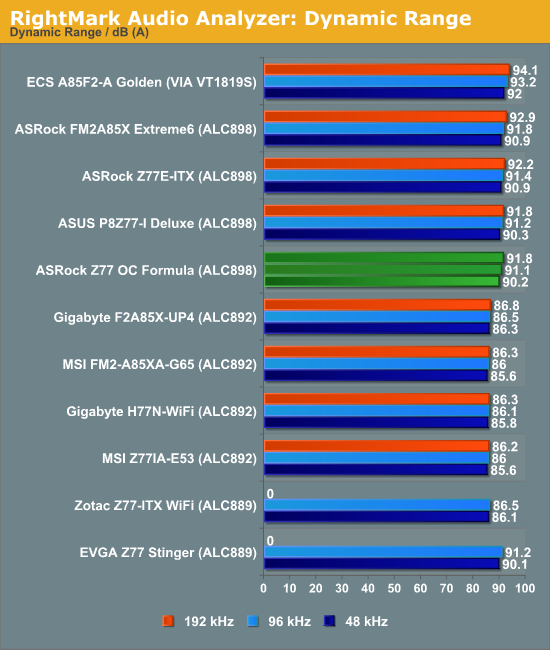
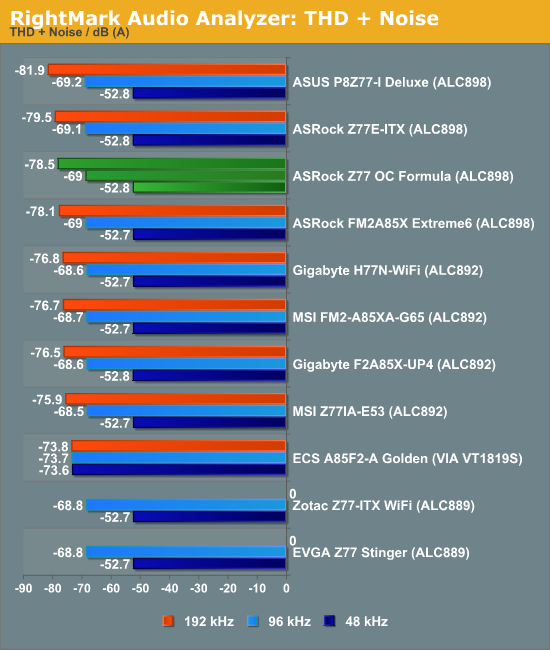
Despite the use of an Realtek ALC898, the ASRock Z77 OC Formula at least holds up against the others.
USB 3.0 Backup
For this benchmark, we run CrystalDiskMark to determine the ideal sequential read and write speeds for the USB port using our 240 GB OCZ Vertex3 SSD with a SATA 6 Gbps to USB 3.0 converter. Then we transfer a set size of files from the SSD to the USB drive using DiskBench, which monitors the time taken to transfer. The files transferred are a 1.52 GB set of 2867 files across 320 folders – 95% of these files are small typical website files, and the rest (90% of the size) are the videos used in the WinRAR test.
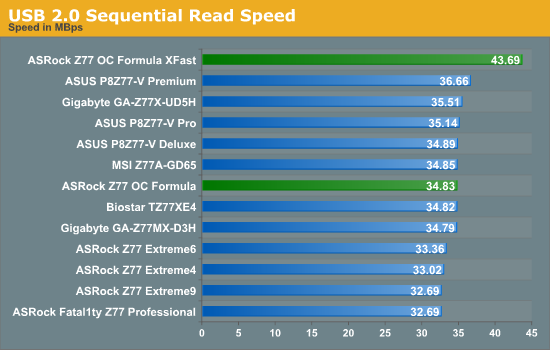
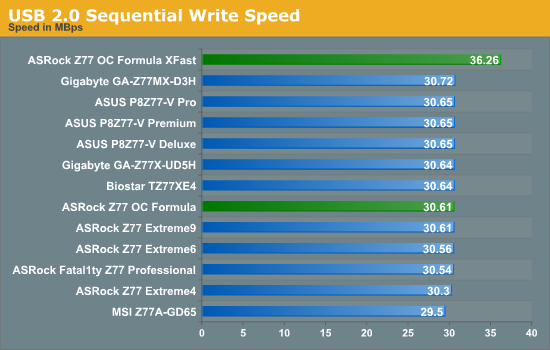
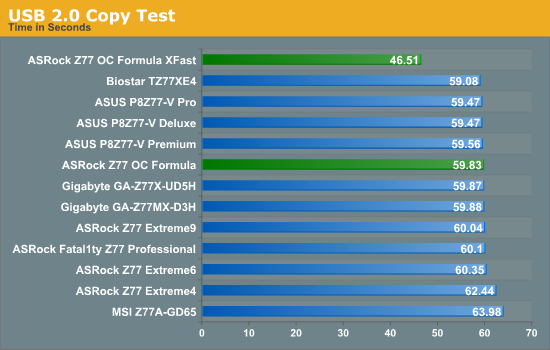
The USB 2.0 copy test is a great result at under 60 seconds, though abusing XFast USB for USB 2.0 gives the ASRock an even bigger edge.
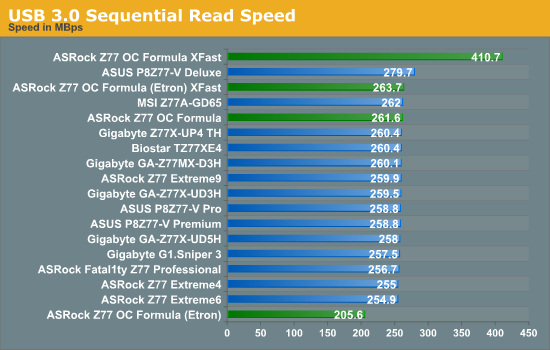
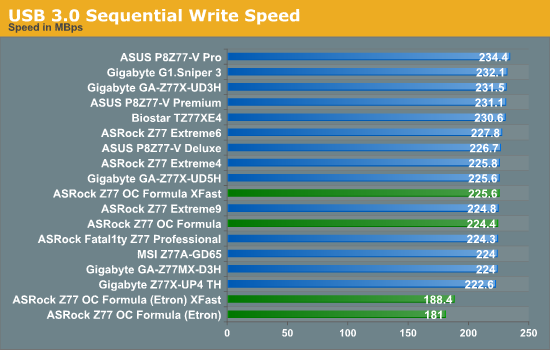
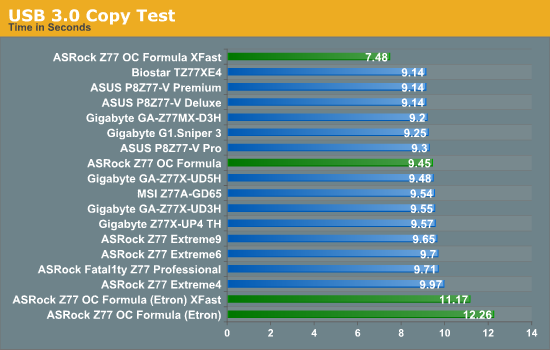
XFast USB again has a clear role to play when dealing with the chipset USB ports. The Etron USB controller does not benefit as much as expected – the Etron is a four port USB controller, which is a little different to the two-port USB controllers seen on most other motherboards.
DPC Latency
Deferred Procedure Call latency is a way in which Windows handles interrupt servicing. In order to wait for a processor to acknowledge the request, the system will queue all interrupt requests by priority. Critical interrupts will be handled as soon as possible, whereas lesser priority requests, such as audio, will be further down the line. So if the audio device requires data, it will have to wait until the request is processed before the buffer is filled. If the device drivers of higher priority components in a system are poorly implemented, this can cause delays in request scheduling and process time, resulting in an empty audio buffer – this leads to characteristic audible pauses, pops and clicks. Having a bigger buffer and correctly implemented system drivers obviously helps in this regard. The DPC latency checker measures how much time is processing DPCs from driver invocation – the lower the value will result in better audio transfer at smaller buffer sizes. Results are measured in microseconds and taken as the peak latency while cycling through a series of short HD videos - under 500 microseconds usually gets the green light, but the lower the better.
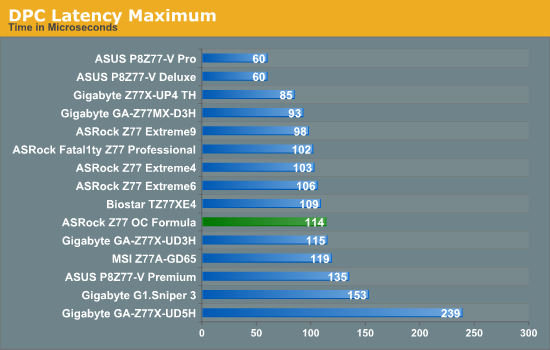
114 microseconds is a great result for the ASRock Z77 OC Formula, well inside the 200 microsecond ‘great’ mark.










48 Comments
View All Comments
irsmurf - Thursday, January 17, 2013 - link
The medals are super janky. For having such a clean site, you'd think they could scrounge up $50 for those simple images. If he can't find them on these forums, There are a few talented artists on Something Awful's FS/FT forum.KPRage - Wednesday, January 16, 2013 - link
Why isn't the Maximus V gene or, Extreme in the comparison list? Will this not be a more appropriate comparison to be made for an OC board?Thanks,
KP
zeehan - Wednesday, January 16, 2013 - link
Forgive me if Im wrong guys, But the car certainly Looks like a Lamborghini Aventador to me :PMaraque - Wednesday, January 16, 2013 - link
It is a Lamborghini Aventador.IanCutress - Friday, January 25, 2013 - link
Changed. I recently watched the Top Gear USA + UK Aventador episodes again, and yup, it's that :)Olotila - Wednesday, January 16, 2013 - link
I am considering buying this board or extreme6, and this one thing seems quite advanced technology ...How can you have raid of at least three disks if you have only two ports?
"2 x SATA 6.0 Gbps (Chipset), RAID 0, 1, 5, 10"
Kevin G - Wednesday, January 16, 2013 - link
The RAID5 and 10 functionality are shared between the two 6 Gbit and four 3 Gbit SATA ports from the chipset. Thus you have a total of six ports to build a RAID5 or RAID10 array.Olotila - Wednesday, January 16, 2013 - link
Ok so not very optimal for say four fast ssd's in raid 10, right? Darn.oiVoodsio - Thursday, January 17, 2013 - link
The box art is not a Lambo of any sort, the murci has a flat bottom unlike the box. The box has more of the Ferrari Enzo look to the front spoilers. I'd say its a modified Enzo which was designed and inspired by F1 Racing.IanCutress - Friday, January 25, 2013 - link
The headlights point towards Lamborghini, but the front intake and grills were confusing me and it's not standard. Turns out the only Lambo with that is the Aventador.